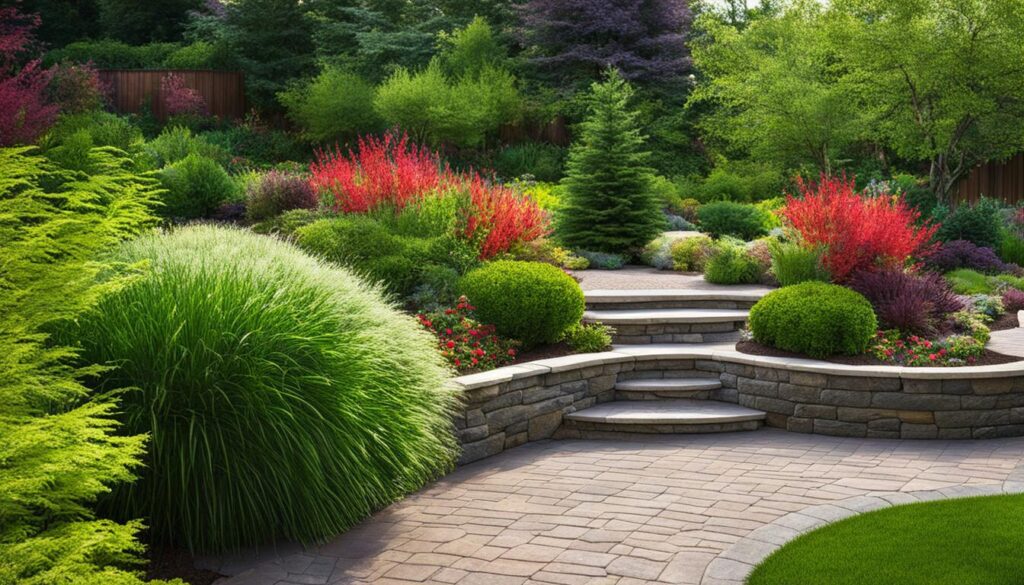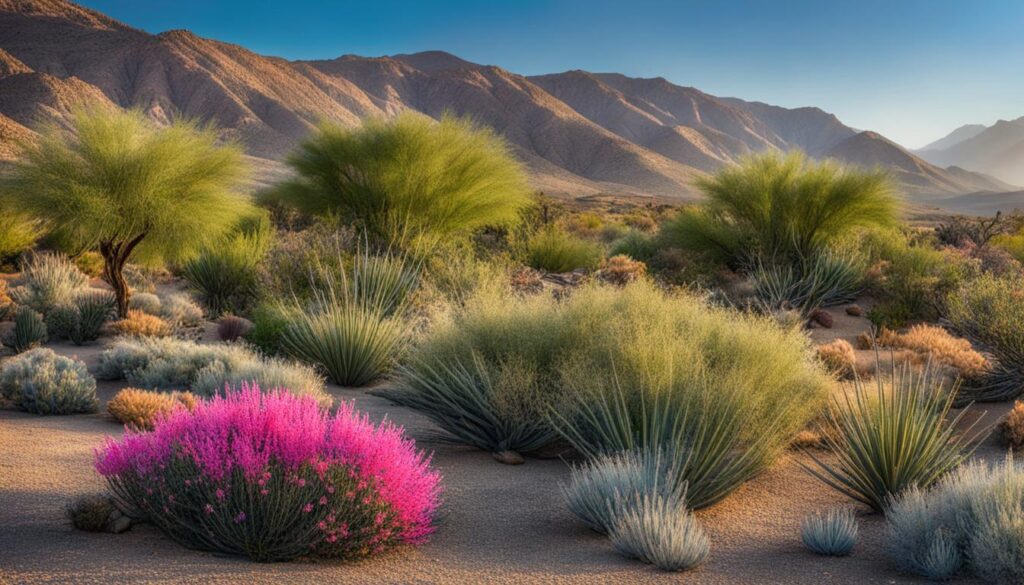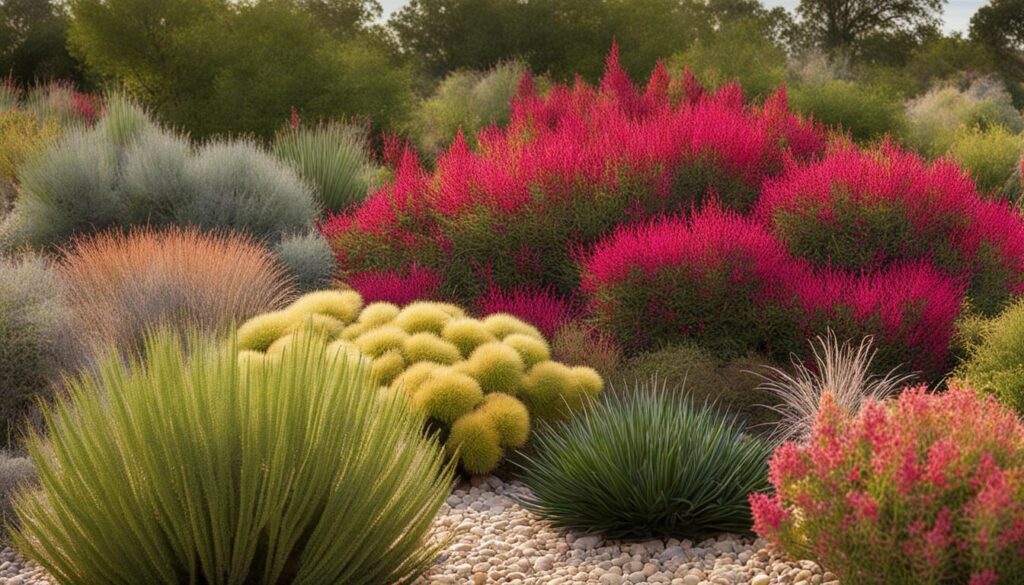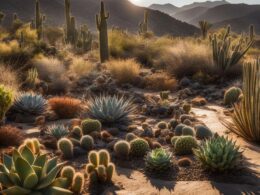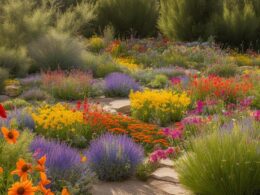Native shrubs are the perfect choice for creating sustainable and low-maintenance landscapes in the United States. With their ability to thrive in local soils and climates, native shrubs are ideal for xeriscape environments. By incorporating these plants into your garden, you can enhance its beauty while conserving water and supporting local ecosystems.
Key Takeaways:
- Native shrubs are well-adapted to local soils and climates in the US.
- They are ideal for creating sustainable and low-maintenance landscapes.
- By choosing native shrubs, you can conserve water and support local ecosystems.
- Xeriscape environments benefit from the use of native shrubs.
- Enhance your garden’s beauty with a variety of native shrub species.
The Benefits of Native Shrubs in Sustainable Landscapes
Native shrubs offer numerous benefits in creating sustainable landscapes. These plants, which are naturally found in specific regions, have evolved to thrive in local soils and climates, making them well-suited for xeriscape environments. Incorporating native shrubs into your landscape design not only enhances the beauty of your garden but also promotes environmental stewardship and biodiversity conservation.
1. Supporting Biodiversity: Native shrubs play a crucial role in supporting local ecosystems by providing habitat and food for wildlife. These plants attract a variety of birds, butterflies, and beneficial insects, contributing to the overall biodiversity of your garden. By incorporating native shrubs, you are creating a sustainable habitat that supports the interconnected web of life.
2. Water Conservation: Native shrubs have adapted to their local climates and are more resistant to drought conditions compared to non-native species. Their deep root systems efficiently absorb water and reduce water runoff. By planting native shrubs in your xeriscape design, you can significantly reduce the need for irrigation and conserve water, making your landscape more sustainable.
“Native shrubs attract birds, butterflies, and beneficial insects, contributing to the overall biodiversity of your garden.”
3. Low Maintenance: Native shrubs are inherently well-adapted to the local environment, requiring minimal care once established. These plants have evolved to withstand the natural elements, including high temperatures and poor soil conditions. By choosing native shrubs, you can enjoy a low-maintenance landscape that thrives without the need for excessive watering, fertilizers, or pesticides.
Incorporating native shrubs in sustainable landscapes not only benefits the environment but also adds visual interest, texture, and color variability to your garden. By choosing these plants, you are making a positive impact on the natural ecosystem while enjoying the beauty and tranquility of a sustainable landscape.
Biodiversity Benefits of Native Shrubs
| Benefit | Description |
|---|---|
| Wildlife Habitat | Native shrubs provide shelter and food sources for birds, butterflies, and beneficial insects, supporting local biodiversity. |
| Pollinator Support | Native shrubs attract pollinators such as bees and butterflies, enhancing the pollination of surrounding plants. |
| Food Chain Support | By attracting diverse wildlife, native shrubs contribute to the food chain, benefiting the overall ecosystem. |
Best Native Shrubs for Xeriscape Environments
When it comes to creating a sustainable xeriscape garden, choosing the right native shrubs is essential. These shrubs are well-adapted to the local climate and require minimal water, making them perfect for xeriscape environments. Here are some of the best native shrubs you can incorporate into your landscape:
1. Winterberry Holly
Winterberry Holly, also known as Ilex verticillata, is a deciduous shrub that thrives in xeriscape environments. It is prized for its vibrant red berries that persist throughout the winter, providing a pop of color in your garden. This shrub is low maintenance, drought-tolerant, and attracts birds to your landscape.
2. Arrowwood Viburnum
Arrowwood Viburnum, or Viburnum dentatum, is a versatile and hardy shrub that can adapt to a wide range of soil conditions. It features clusters of white flowers in the spring, followed by glossy blue-black berries in the fall. This native shrub attracts butterflies and birds, making it a great addition to any xeriscape garden.
3. Creeping Juniper
Creeping Juniper, scientifically known as Juniperus horizontalis, is a low-growing evergreen shrub that adds texture and color to your xeriscape garden. It has dense foliage that forms a beautiful ground cover, making it ideal for erosion control and weed suppression. This shrub is drought-tolerant and requires minimal maintenance.
4. American Filbert
American Filbert, or Corylus americana, is a deciduous shrub that produces delicious edible nuts. It has attractive green foliage during the spring and summer, which turns yellow in the fall. This shrub is adaptable to various soil types and requires little watering once established, making it a great choice for xeriscape environments.
5. Buttonbush
Buttonbush, scientifically known as Cephalanthus occidentalis, is a native shrub that thrives in wetter xeriscape environments. It features unique spherical flower clusters that attract butterflies and bees. This shrub is ideal for rain gardens, pond edges, or any area with consistently moist soil.
6. Creeping Sand Cherry
Creeping Sand Cherry, or Prunus pumila, is a low-growing shrub with beautiful pink or white flowers in the spring. It has a spreading habit, making it suitable for ground covers and erosion control. This native shrub is drought-tolerant and requires minimal maintenance once established.
7. Northern Bush Honeysuckle
Northern Bush Honeysuckle, scientifically known as Diervilla lonicera, is a deciduous shrub with clusters of yellow flowers in the summer. It has attractive green foliage that turns a vibrant red in the fall. This shrub is drought-tolerant, deer-resistant, and attracts hummingbirds to your garden.
8. Sweet Fern
Sweet Fern, or Comptonia peregrina, is a unique shrub that adds fragrance and texture to your xeriscape garden. It has fern-like foliage and releases a pleasant aroma when crushed. This shrub thrives in dry, sandy soils and requires little maintenance once established.
9. Sweet Gale
Sweet Gale, scientifically known as Myrica gale, is a shrub that grows well in wetter xeriscape environments, such as near ponds or streams. It has aromatic leaves and produces cone-like fruits. This native shrub is drought-tolerant once established and attracts birds and butterflies.
Incorporating these native shrubs into your xeriscape design will not only enhance the beauty of your landscape but also conserve water and support local ecosystems. Remember to choose shrubs that are well-suited to your specific climate and soil conditions for optimal success.
Incorporating Native Shrubs in Xeriscape Designs
When designing a xeriscape garden with native shrubs, it is important to consider the watering needs and light requirements of each species. By understanding these factors, you can create a harmonious and sustainable landscape that thrives with minimal water usage. Grouping plants with similar watering needs together allows for more efficient irrigation and reduces water waste. This approach also ensures that each plant receives the appropriate amount of water, promoting their overall health and vitality.
Native shrubs can be incorporated into xeriscape designs in various ways. They can serve as focal points, adding visual interest and creating a sense of depth in the landscape. By strategically placing native shrubs throughout your garden, you can create a natural flow and define different areas within the space. Additionally, native shrubs can be used as hedges or ground covers to add texture and structure to your xeriscape design.
Proper planning is crucial when incorporating native shrubs into your xeriscape design. Consider the mature size of each shrub to ensure they have adequate space to grow without overcrowding other plants or structures. Take into account their preferred exposure to sunlight and shade, and plan their placement accordingly. By thoughtfully incorporating native shrubs into your xeriscape design, you can create a visually appealing and sustainable landscape that celebrates the beauty of indigenous plant species.
Table: Native Shrubs for Xeriscape Designs
| Shrub | Watering Needs | Light Requirements | Height at Maturity |
|---|---|---|---|
| Winterberry Holly | Low to moderate | Full sun to part shade | 6-10 feet |
| Arrowwood Viburnum | Moderate to high | Full sun to part shade | 6-10 feet |
| Creeping Juniper | Low | Full sun | 6-12 inches |
| American Filbert | Low to moderate | Full sun to part shade | 6-10 feet |
| Buttonbush | Moderate to high | Full sun to part shade | 5-12 feet |
| Creeping Sand Cherry | Low | Full sun | 6-12 inches |
| Northern Bush Honeysuckle | Low to moderate | Full sun to part shade | 3-6 feet |
| Sweet Fern | Low | Full sun to part shade | 2-4 feet |
| Sweet Gale | Low | Full sun to part shade | 3-6 feet |
Table: Native shrubs that are well-suited for xeriscape designs, showcasing their watering needs, light requirements, and height at maturity. These native shrubs offer a diverse range of options to enhance your xeriscape garden, bringing beauty, sustainability, and water conservation to your landscape.
With careful consideration of native shrubs and thoughtful design, you can create a stunning xeriscape garden that incorporates the beauty and benefits of indigenous plant species. By choosing native shrubs, you are not only conserving water but also supporting local ecosystems and promoting biodiversity. Embrace the potential of incorporating native shrubs in your xeriscape design and create an environmentally-friendly and visually captivating landscape that thrives in US climates.
Xeriscaping Techniques for Water Conservation
Xeriscaping is a landscaping technique that promotes water conservation and reduces the need for irrigation. By implementing xeriscaping techniques in your landscape design, you can create a visually appealing and sustainable environment. Here are some key xeriscaping techniques to consider:
1. Select Drought-Tolerant Plants
Choose plants that are well-adapted to your local climate and require minimal water. Drought-tolerant plants, such as succulents, ornamental grasses, and native shrubs, are excellent choices for xeriscape environments. These plants have evolved to thrive in arid conditions and can withstand periods of drought without the need for excessive watering.
2. Group Plants Based on Water Needs
When planning your xeriscape garden, group plants with similar water requirements together. This allows for efficient water usage as you can irrigate these plants accordingly. By creating separate zones based on water needs, you can avoid overwatering or underwatering certain plants, ensuring optimal growth and water conservation.
3. Use Targeted Irrigation Systems
Consider installing targeted irrigation systems, such as drip irrigation, in your xeriscape design. Drip irrigation delivers water directly to the plant’s root zone, reducing evaporation and water waste. This method ensures that water is used efficiently and reaches the plants that need it most, while minimizing runoff and water loss.
4. Mulch to Reduce Water Evaporation
Apply a layer of mulch around your plants to help conserve moisture and reduce water evaporation from the soil. Organic mulches, such as wood chips or bark, also help regulate soil temperature and suppress weed growth. Mulching not only conserves water but also improves the overall health and vitality of your xeriscape garden.
5. Maintain Plants to Prevent Excessive Water Needs
Regularly maintain your xeriscape plants to keep them healthy and prevent excessive water needs. Prune shrubs and trees to remove dead or damaged branches, promoting better water uptake and reducing water requirements. Proper plant maintenance, including fertilizing, pest control, and weed management, ensures that your xeriscape garden remains vibrant and resilient.
By implementing these xeriscaping techniques, you can create a water-efficient and environmentally-friendly landscape. Xeriscaping not only conserves water but also reduces maintenance requirements and creates a visually stunning garden that can thrive in drought-prone areas. Embrace the power of xeriscaping and be part of the solution for a sustainable future.
Benefits of Xeriscaping in Sustainable Landscape Design
Xeriscaping offers several benefits in sustainable landscape design. By incorporating water-efficient techniques and native plants, you can create an environmentally-friendly and visually appealing garden. Let’s explore the advantages of xeriscaping:
Water Conservation
One of the primary benefits of xeriscaping is water conservation. By selecting drought-tolerant plants and implementing efficient irrigation systems, you can significantly reduce water usage. Xeriscaping typically requires up to 50% less water compared to traditional landscaping methods, making it an ideal choice for regions prone to drought.
Low Maintenance
Another advantage of xeriscaping is its low maintenance requirements. Native plants are well-adapted to local climates, reducing the need for excessive watering, fertilizing, and pest control. By choosing plants that thrive in your specific region, you can save time and effort on garden maintenance, allowing you to enjoy your landscape more and worry less about upkeep.
Environmental Benefits
Xeriscaping promotes environmental sustainability in multiple ways. Native plants provide habitat and food sources for local wildlife, supporting biodiversity and ecological balance. Additionally, the decreased need for herbicides and pesticides in xeriscaped gardens minimizes chemical runoff into local water sources, creating a healthier ecosystem for plants and animals alike.
Aesthetic Appeal
Contrary to popular belief, xeriscaping can yield stunning visual results. Native plants come in a variety of shapes, colors, and textures, allowing you to create a diverse and visually appealing landscape. By incorporating different foliage types and seasonal blooms, you can design a beautiful garden that harmonizes with the natural surroundings and enhances the curb appeal of your property.
| Benefits of Xeriscaping | Description |
|---|---|
| Water Conservation | Reduces water usage by up to 50% compared to traditional landscaping methods. |
| Low Maintenance | Requires minimal watering, fertilizing, and pest control. |
| Environmental Benefits | Supports biodiversity, reduces chemical runoff, and provides habitat for wildlife. |
| Aesthetic Appeal | Offers a visually stunning landscape with a variety of native plants. |
What are the Best Native Shrubs for Xeriscape Environments in the US?
Looking to master xeriscaping with native trees? The United States offers a diverse range of shrubs that thrive in xeriscape environments. Some top choices include the Desert Marigold, Apache Plume, and Texas Ranger. These hardy plants require minimal water and maintenance, making them perfect for conserving resources in dry regions.
Conclusion
Native shrubs are an excellent choice for creating sustainable and visually appealing landscapes in xeriscape environments. These shrubs are well-adapted to local soils and climates, making them perfect for conserving water and supporting local ecosystems. By incorporating native shrubs into your xeriscape design, you can enhance your garden while promoting biodiversity and water conservation.
With their ability to provide habitat for wildlife and support pollinators, native shrubs play a crucial role in maintaining the ecological balance of your landscape. Their resilience to harsh conditions such as high temperatures and inadequate water supply makes them a reliable and low-maintenance option for any US climate. By selecting the best native shrubs for your xeriscape garden, you can create a beautiful and sustainable outdoor space.
Incorporating native shrubs into your xeriscape design is not only beneficial for the environment but also for you as a gardener. These drought-tolerant plants require less water, reduce the need for irrigation, and minimize the use of herbicides and pesticides. They offer a wide range of sizes, colors, and textures, allowing you to create a visually diverse and captivating landscape.
So, why wait? Explore the wide variety of native shrubs available and enhance your xeriscape garden with these environmentally-friendly and resilient plants. With their numerous benefits, native shrubs are the perfect choice for anyone looking to create a sustainable and thriving landscape in xeriscape environments.






